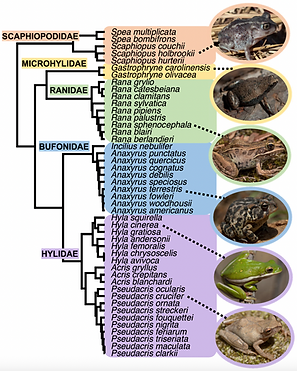
Research
Comparative Studies of Genomic Variation within Species
A core theme of our research is focused on how species have responded to environmental change in the past and whether they have the capacity to adapt to changing environments in the future. We characterize genetic variation within species across geographic space (spanning macrogenetics to phylogeography to population genomics) to determine how historical processes, contemporary landscapes, and species traits influence their genetic patterns.
-
Some of these studies use repurposed data for hundreds of species to assess predictors of genetic diversity within species. For example: Barrow et al. 2021; Amador et al. 2024
-
We also generate and analyze new genome-wide sequence data (e.g. ddRAD, target capture) to conduct population-level and phylogeographic studies in a comparative framework. For example: Barrow et al. 2018; Larkin et al. 2023; Nava Martinez et al. 2025
-
Detailed studies of focal species complexes also provide important insights into the geographic boundaries and evolutionary history of species of interest. For example: Barrow et al. 2015; on-going projects on the Pacific Chorus Frog and Six-lined Racerunners


Host-Parasite and Pathogen Community Dynamics
Changes in species distributions lead to novel interactions between species. Such range shifts are expected to occur with increasing frequency because of climate change and the introduction of invasive species in our increasingly globalized world. One aspect of our research focuses on describing the abundance, diversity, and host associations of poorly-documented parasites and pathogens to better understand the potential for these interactions to occur.
-
Some of of our favorite systems are vertebrate blood parasites, which have provided insights into differences in host susceptibility, drivers of parasite community turnover, and parasite specialization. For example: Marroquin-Flores et al. 2017; Barrow et al. 2019; Barrow et al. 2021; McNew et al. 2021
-
We are also fascinated by multi-host, multi-pathogen infection dynamics and uncovering the environmental and biological predictors of infection, particularly for amphibian pathogens. For example: Torres López et al. 2024; Wiley et al. 2025
-
Motivated undergraduates also make creative use of our museum specimens to study trends in parasites and pathogens over time. For example: Irvin Arroyo-Torres's project on Western Diamond-backed Rattlesnake parasites over 75 years; Hannah Bradley's project searching for snake fungal disease in New Mexico



Ecology and Evolution of Species of Concern
Another theme in our research is to better understand ecological and evolutionary processes in species of concern, including species of conservation concern and invasive species that may be negatively impacting natural communities and ecosystems. We aim to contribute knowledge needed to develop or improve conservation and management plans.
-
We began sampling freshwater turtles along the Middle Rio Grande of New Mexico in 2022 to characterize communities and assess potential impacts of the invasive Red-eared Slider on native species. Graduate students Jonathan Duran, Esteban Rosario Sanchez, and several Sevilleta REU students have been instrumental in these efforts. For example: Duran et al. 2024
-
Several projects apply genetic tools and analyses to species of concern to better understand genetic diversity and connectivity in these populations. For example: Barrow et al. 2015; Kotze et al. 2019; on-going projects on introduced American Bullfrogs in New Mexico

Building Collections and Supporting an Open Data Philosophy
Natural history collections are essential for understanding global biodiversity across time and space. They provide an unmatched historical record to address crucial questions of importance to society, and continued collection building is imperative in this time of rapid global change. We aim to build research collections for the future, enhance the value of existing collections for cutting-edge research, and train the next generation of scientists in open-data practices that are critical for addressing biodiversity challenges.
-
Our research projects have contributed thousands of extended specimens associated with high-quality cryopreserved tissues, thin blood smears, and whole specimens. Search the MSB:Herp collection via the Arctos collection management system.
-
You can read more about our viewpoints in Miller et al. 2020 and Nachman et al. 2023
